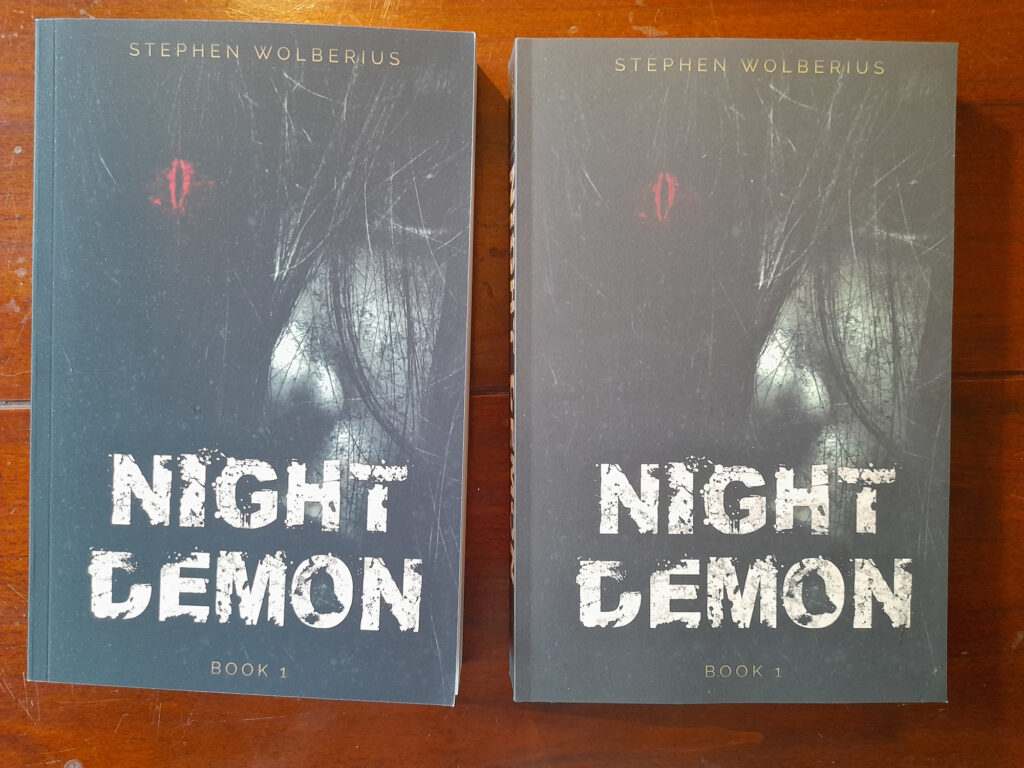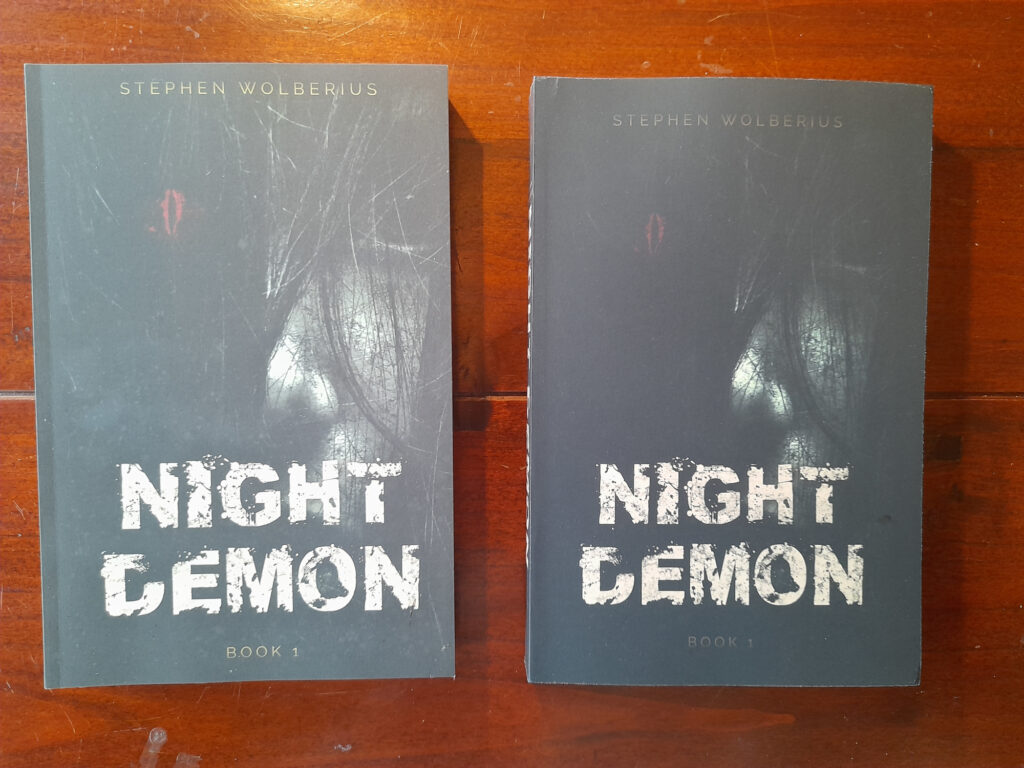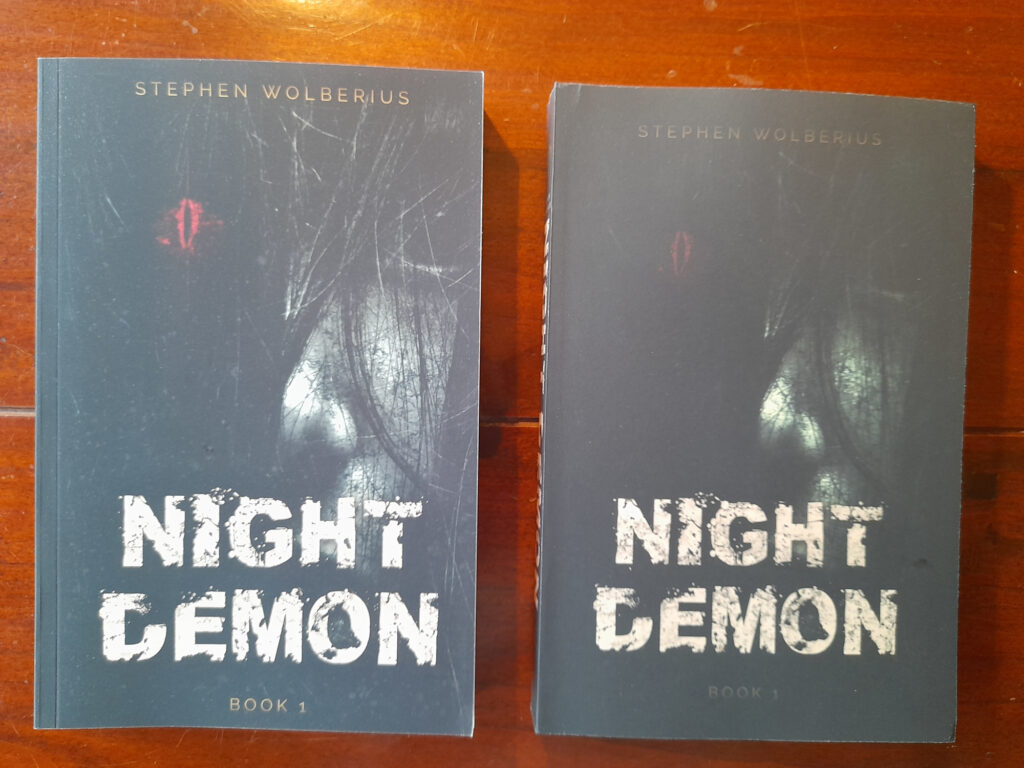Many of you are wondering, Stephen, where are those sleeved high-covers of Night Demon you promised? You know, the larger ones with extra art under the sleeve and 10 pages worth of extra content (my conlang, Elilim). Well, read on.
As an independently published author, I work with printers directly as opposed to through a publishing company. This has advantages, and this has disadvantages, like everyone else in life. An advantage is slightly higher royalties since I don’t have a publishing house or an agent who takes a cut. Another advantage is that I can write what I want, and it will be published. There are no gatekeepers like agents, and I’m not beholden to whatever current thing is in vogue with traditional publishers. But, of course, the disadvantage is that I have to do everything myself except print the book.
This printing is done largely by two printing companies, one being Amazon and the other a far less known entity among the general public: Lightning Source. It’s with Lightning Source where the problems have arisen. See, Amazon will only make books available on Amazon. There is an option for wider distribution, but it’s quite appalling. Lightning Source, on the other hand, has spectacular global distribution. My book is now available for order pretty much globally. If it sells books, it can stock or at least order Night Demon.
To top it off, Lightning Source is considered the epitome when it comes to print quality for independent authors like myself. When you look up its front-end company called IngramSpark, the oft-heard pro of going with Lightning Source is that its print quality is better even than Amazon’s. Others may hold that Amazon itself prints its books with Lightning Source and that all (yes, all) small to mid-sized publishers that aren’t in the top-4 use Lightning Source services for print.
I’m here to dispute that quality claim.
When I set up the print files (the cover files specifically), I did so for both Amazon and Lightning Source. I did some tests with Amazon until I was happy with the results. For Amazon, this looked fine. For Lightning Source, however, it did not. Not by a long shot! The picture below is a side-by-side comparison of the Amazon print (left) and the Lighting Source print (right). These use the exact same file:

You’ll notice immediately that the darker colours are executed way better by Amazon than by Lightning Source. The highlights (red) also jump out more, and the contrast is much sharper. The Lightning Source paperback just looks washed out.
In Lightning Source’s defence, covers are made on the computer using what’s called an RGB colour profile. These colours range up to 16 million different colour combinations. A physical printer cannot mimic the brightness and contrast of a computer screen. Instead, printers use a CMYK colour profile. I haven’t adjusted the RBG profiles to CMYK for Amazon or what I sent to Lightning Source. The first test that came back from Amazon looked way too dark. My solution was to adjust the brightness and contrast, making the print-file look washed out but the physical print copy look like the ones in the picture
I was dissatisfied that outside of Amazon, anyone who bought my book would get this washed-out cover. I tried again and sent Lightning Source a CMYK-adjusted version without adjusting the brightness. These are the results (the original version on the left from Lightning Source and the new CMYK version on the right):

Now the contrast is completely gone, all the details are darker, and somehow, it still looks washed out. This is odd for a renowned printing company that is supposed to be of superior quality to Amazon. It simply isn’t. The interior, too, is probably the same quality, and the binding is on par with Amazon’s. Nothing special about either of them.
As a last comparison, here is the last CMYK version of Lighting Source (right) compared to the Amazon version (left):

I’m simply not convinced that this notion of Lightning Source having better quality than Amazon holds true. At least, from my experience, it’s sooner the opposite. Even if the colours were correct, the books are practically the same when it comes to paper, thickness (the Amazon paperback is actually a tiny bit thicker) and interior print quality.
What also doesn’t help at all is that it takes Lightning Source close to 2 weeks to send a copy from the UK to the Netherlands. There is no way to verify whether the print file you sent will be anywhere close to acceptable either. So it’s a matter of trying something with your colour profile, sending it in, ordering a book, waiting 2 weeks and rinse and repeat this process.
This all ties in with the sleeved high covers. They were to be printed by Lightning Source. However, I cannot justify asking 27.- and perhaps more + shipping for a completely inferior product with my name on it. So, for now, there will be no sleeved high covers. I’ve also asked Lightning Source to stop the worldwide distribution of Night Demon. This means that, in a couple of days, print copies will only be available through Amazon.
Sadly, Amazon does not offer sleeved versions. Lightning Source is really the only option we have, and, unfortunately, they’re not a really good option at all. Barnes & Noble, Draft2Digital, and so on, all also use Lightning Source printers so, too bad, I guess.
I will be trying to correct this problem, but it will depend on Lightning Source also responding and giving me solutions. Until then, my hands are tied. To end this post on a good note, I’ve decided to sell signed copies of Night Demon through my bookshop for the same price as regular copies on Amazon.
